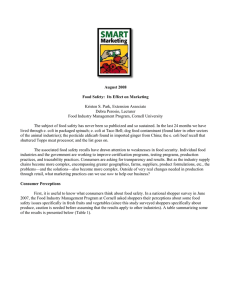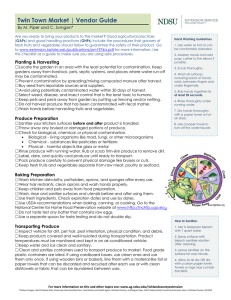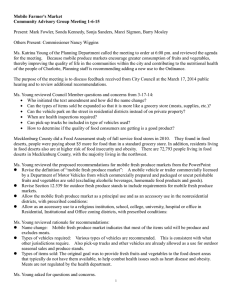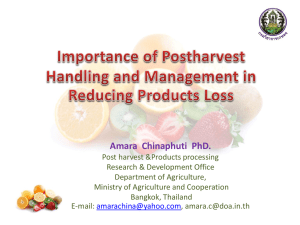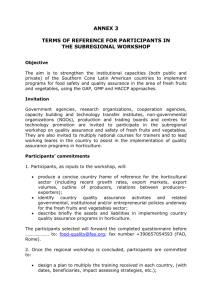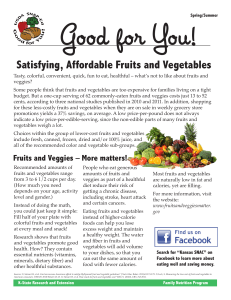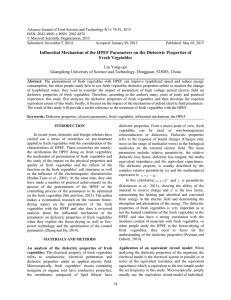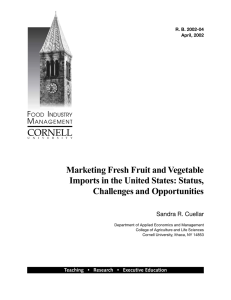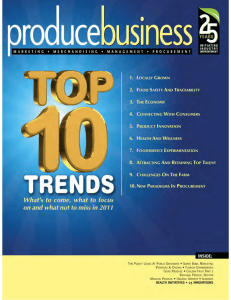Assuring Produce Safety: A Key Industry Marketing Strategy
advertisement
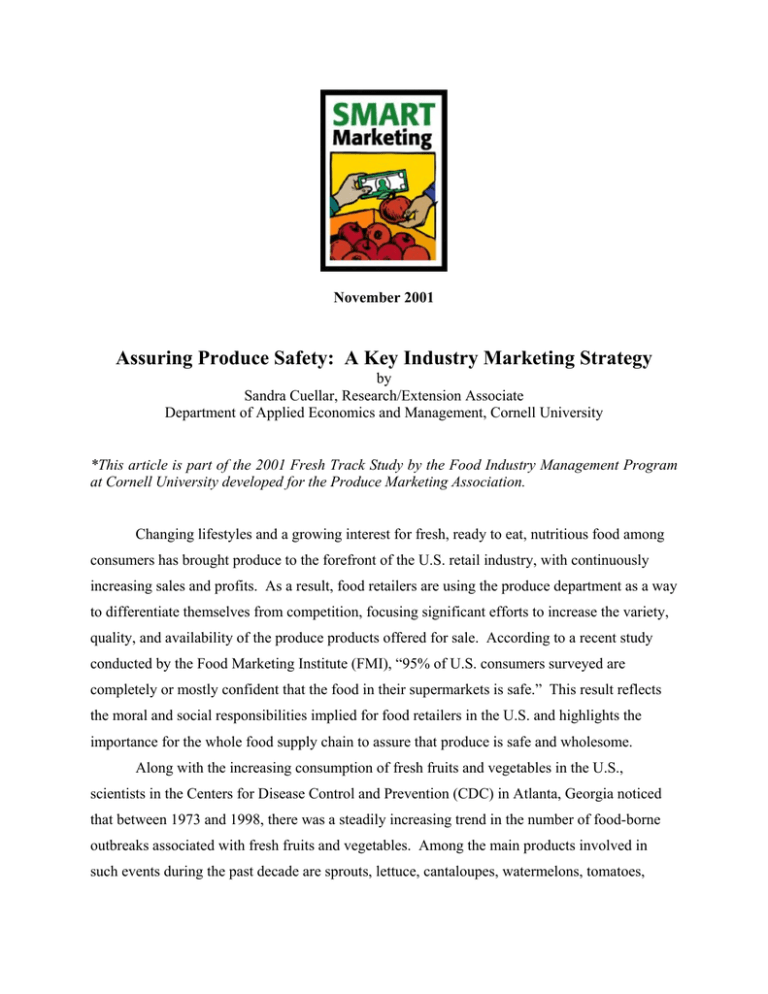
November 2001 Assuring Produce Safety: A Key Industry Marketing Strategy by Sandra Cuellar, Research/Extension Associate Department of Applied Economics and Management, Cornell University *This article is part of the 2001 Fresh Track Study by the Food Industry Management Program at Cornell University developed for the Produce Marketing Association. Changing lifestyles and a growing interest for fresh, ready to eat, nutritious food among consumers has brought produce to the forefront of the U.S. retail industry, with continuously increasing sales and profits. As a result, food retailers are using the produce department as a way to differentiate themselves from competition, focusing significant efforts to increase the variety, quality, and availability of the produce products offered for sale. According to a recent study conducted by the Food Marketing Institute (FMI), “95% of U.S. consumers surveyed are completely or mostly confident that the food in their supermarkets is safe.” This result reflects the moral and social responsibilities implied for food retailers in the U.S. and highlights the importance for the whole food supply chain to assure that produce is safe and wholesome. Along with the increasing consumption of fresh fruits and vegetables in the U.S., scientists in the Centers for Disease Control and Prevention (CDC) in Atlanta, Georgia noticed that between 1973 and 1998, there was a steadily increasing trend in the number of food-borne outbreaks associated with fresh fruits and vegetables. Among the main products involved in such events during the past decade are sprouts, lettuce, cantaloupes, watermelons, tomatoes, strawberries, raspberries, scallions, basil, and parsley. The most commonly involved pathogens have been several strains of Salmonella, E Coli O157:H7, Hepatitis A, Cyclospora cayetanensis, Shigella sonnei, Staphylococcus aureus, Campylobacter jejuni, and Clostridiuym botulinum. The occurrence of food-borne illness outbreaks can mean irreparable damage to a business, both from the legal point of view as well as from the negative impact on its brand and company reputation. Currently, there are no mandatory rules for the safe growing and packing of fruits and vegetables, except for those regulating water and pesticide residues under the surveillance of EPA. In October 1998, FDA rolled out the “Guide to Minimize Microbial Food Safety Hazards for Fresh Fruits and Vegetables,” comprising a set of Good Agricultural Practices (GAPs). Although, it is currently optional, many in the produce industry are incorporating these practices into their operations as quickly as possible, in an effort to preempt the possibility of stringent regulations by FDA. Keeping produce safe is no easy task. There are many opportunities where fresh fruits and vegetables can be contaminated on their way from field to table. In the field, produce can be contaminated through soil, water, and pests and, very importantly, by inadequate or mishandled chemicals (i.e. pesticides). During harvesting, the major risk of contamination comes from handling by workers who may be the carriers of pathogens. During packing of fresh produce, the risks lie with contaminated packaging equipment and supplies, especially while processing and packaging of pre-cut products which involves several safety hazard points. Distribution of produce in trucks, which might be contaminated from previous cargoes or due to lack of temperature controls in them, also represents a major threat to produce safety. At retail, storage of produce, handling by employees for display, as well as handling by consumers, all represent important risks of contamination. Finally, though not necessarily less important, mishandling of produce by consumers and the chance of cross contamination of the products at home are yet other hazards to the safety of produce. It is clear, then, that there are specific responsibilities in keeping produce safe at each stage along the supply chain. The confidence that consumers have in their supermarkets along with the new incidence of food-borne illnesses caused by tainted produce in the United States may explain recent food safety requests from retailers. Some of the major supermarket chains, and foodservice operators as well, now require suppliers to not only follow the GAP's guidelines but also to obtain third- 2 party audits as a prerequisite for doing business. These new demands have created a great deal of controversy in the industry. While some see third-party audits as a way to raise the quality and safety of produce and a training tool to build a food safety program, others view them as an excessive and costly method, mainly geared to limit retailers’ liabilities but not necessarily resulting in increased safety. A major consideration of third-party audits is their cost. They range from tens of thousands to a few hundred thousand dollars, a cost exclusively absorbed by the growers. This can be difficult or even impossible for small growers to afford, eventually driving them out of the market. Interestingly, some major supermarket organizations are looking at produce safety from a system-wide management approach, where all parties involved in the supply chain acknowledge their responsibilities. In this approach, knowing your business partners and the relationship you have with them becomes the key. This approach to produce safety may prove particularly challenging under the present circumstances of consolidation where long-term vendor-buyer relationships have been eroding, and no clear future trend in this respect is yet defined. On the other hand, it may prove a new buyer-seller paradigm could be a key mechanism in developing such collaboration throughout the produce supply chain. One example is that some producers in California have established a “university” concept whereby they can lavish their hospitality upon their buyers in the form, often, of entertainment, while in serious seminars, educating them on the special nature and opportunities with their particular commodity. Such buying “visits” to shipping points(s) generally result in a better understanding of the vendor’s typical dilemmas by the buyer and ,ideally, improve collaboration and coordination system wide. As there is no single clear-cut solution to assuring produce safety thus far, it is evident that the produce industry needs to develop creative cost-efficient procedures with which it can address the hazards involved at the different stages along the distribution channel. Perhaps making use of innovative technologies, developing new schemes of collaboration among its members, and even providing information to consumers will bring about an industry-wide proposition and allow the industry to ensure the safety of its products while fulfilling the expectations of its customers for high quality and good value. "Smart Marketing" is a monthly marketing newsletter for extension publication in local newsletters and for placement in local media. It reviews the elements critical to successful marketing in the food and agricultural industry. Articles are written by faculty members in the Department of Applied Economics and Management at Cornell University. 3 "Share the gift of communication." Please cite or acknowledge when using this material. 4
